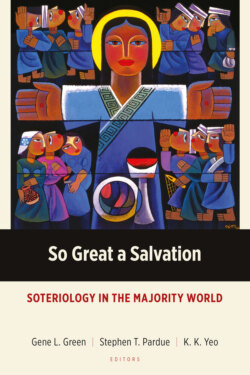Читать книгу So Great a Salvation - Группа авторов - Страница 7
На сайте Литреса книга снята с продажи.
Sin and Salvation: Toward a Soteriology of Truth, Goodness, and Beauty
ОглавлениеSoteriology presupposes hamartiology (the doctrine of sin), but “sin” (or the “power of sin”) is understood as all that impedes God’s creation of superabundant life.[11] Yet salvation is not simply sin being broken, evil overcome, wrong forgiven. Salvation is also the broken image of God restored, God’s presence and love and justice fully realized, and paradise regained—encompassing the past and present to the end of time (eschaton). The problems of humanity and the world we live in are real: the morbid condition of the brokenness in human beings and in their well-being with their Creator and creation, the prevalence of sin that binds and curses life in the cosmos, and the sting of death that obliterates the shalom of earthly flourishing.
There are three hermeneutical frames of sin and salvation, which should be understood as complementing rather than competing with each other since the semantic domain of all three categories is found in the Bible. The first perspective is that of goodness and evil in a moral sense. This view holds that a moral universe of goodness is in essence the psychological health of human beings or the well-being of humanity. The perversion of the order of the moral universe means a departure from its norm; thus, sin is sickness of the soul (Ps. 32:3–5). Salvation then involves finding a cure, a therapy, often resorting to “medications” for healing. Examples are the ritual laws (Leviticus 13–15) on what is clean and what is unclean, and illnesses such as leprosy (Matt. 8:2–4) and blindness (John 9), which are regarded as sins.
The second frame assumes a truthful and legal universe, for God is the Lawgiver, and the laws are divine imperatives for human beings to maintain the principles of all things. Sin is missing the mark (hamartia), doing wrong (ḥāṭā’ or ‘āwâ), or rebelling (pāša‘) against the rules. Sin is law-breaking (1 John 3:4), the result of which is guilt (Psalm 32), and thus salvation is “forensic” justification. The Reformers especially favored this juridical understanding of sin (penal) and judicial atonement.
The third view assumes a holy and beautiful universe, one that is covered with its Creator’s presence and glory. God as the beautiful wisdom (Proverbs 8) is the true nature of creation’s web of relationship and its worthiness. Sin means one has “fallen short of the glory of God” (Rom. 3:23), and salvation is to have God’s image restored in humanity (2 Cor. 3:18) and being clothed in glory (Rom. 13:14; Gal. 3:27).
In sum, salvation is that which is good, true, and beautiful. As Paul writes, “Do not be conformed to this age [aiōn], but be transformed [a major aspect of salvation] by the renewing of your minds [noos], so that you may discern what is the will of God—what is good [virtuous/morality] and acceptable [delightful/beauty] and perfect [whole/truth]” (Rom. 12:2). The interplay of goodness, truth, and beauty can suggest an understanding of salvation as a process in which the aesthetic brings truth and good to our authentic selves and that of the cosmos. Jesus is the image of God (cf. Col. 1:15; Heb. 1:3), and he offers and epitomizes the wholeness and worthiness of humanity as their salvation. Indeed, “the grace of God has appeared bringing salvation to all human beings” (Titus 2:11).
